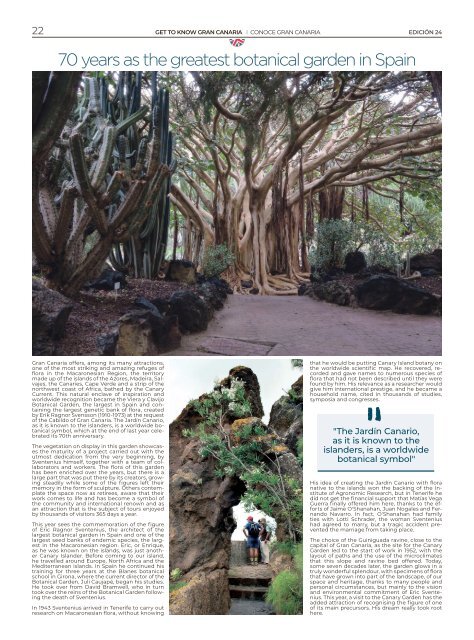No. 24 - Its Gran Canaria Magazine
Rutas, recomendaciones y noticias de Gran Canaria. Routes, tips and news about Gran Canaria.
Rutas, recomendaciones y noticias de Gran Canaria.
Routes, tips and news about Gran Canaria.
Create successful ePaper yourself
Turn your PDF publications into a flip-book with our unique Google optimized e-Paper software.
22<br />
GET TO KNOW GRAN CANARIA I CONOCE GRAN CANARIA EDICIÓN <strong>24</strong><br />
70 years as the greatest botanical garden in Spain<br />
<strong>Gran</strong> <strong>Canaria</strong> offers, among its many attractions,<br />
one of the most striking and amazing refuges of<br />
flora in the Macaronesian Region, the territory<br />
made up of the islands of the Azores, Madeira, Salvajes,<br />
the Canaries, Cape Verde and a strip of the<br />
northwest coast of Africa, bathed by the Canary<br />
Current. This natural enclave of inspiration and<br />
worldwide recognition became the Viera y Clavijo<br />
Botanical Garden, the largest in Spain and containing<br />
the largest genetic bank of flora, created<br />
by Erik Ragnor Svensson (1910-1973) at the request<br />
of the Cabildo of <strong>Gran</strong> <strong>Canaria</strong>. The Jardín Canario,<br />
as it is known to the islanders, is a worldwide botanical<br />
symbol, which at the end of last year celebrated<br />
its 70th anniversary.<br />
The vegetation on display in this garden showcases<br />
the maturity of a project carried out with the<br />
utmost dedication from the very beginning, by<br />
Sventenius himself, together with a team of collaborators<br />
and workers. The flora of this garden<br />
has been enriched over the years, but there is a<br />
large part that was put there by its creators, growing<br />
steadily while some of the figures left their<br />
memory in the form of sculpture. Others contemplate<br />
the space now as retirees, aware that their<br />
work comes to life and has become a symbol of<br />
the community and international renown and as<br />
an attraction that is the subject of tours enjoyed<br />
by thousands of visitors 365 days a year.<br />
This year sees the commemoration of the figure<br />
of Eric Ragnor Sventenius, the architect of the<br />
largest botanical garden in Spain and one of the<br />
largest seed banks of endemic species, the largest<br />
in the Macaronesian region. Eric, or Enrique,<br />
as he was known on the islands, was just another<br />
Canary Islander. Before coming to our island,<br />
he travelled around Europe, <strong>No</strong>rth Africa and the<br />
Mediterranean islands. In Spain he continued his<br />
training for three years at the Blanes botanical<br />
school in Girona, where the current director of the<br />
Botanical Garden, Juli Caujapé, began his studies.<br />
He took over from David Bramwell, who in turn<br />
took over the reins of the Botanical Garden following<br />
the death of Sventenius.<br />
In 1943 Sventenius arrived in Tenerife to carry out<br />
research on Macaronesian flora, without knowing<br />
that he would be putting Canary Island botany on<br />
the worldwide scientific map. He recovered, recorded<br />
and gave names to numerous species of<br />
flora that had not been described until they were<br />
found by him. His relevance as a researcher would<br />
give him international prestige, and he became a<br />
household name, cited in thousands of studies,<br />
symposia and congresses.<br />
"<br />
"The Jardín Canario,<br />
as it is known to the<br />
islanders, is a worldwide<br />
botanical symbol"<br />
His idea of creating the Jardín Canario with flora<br />
native to the islands won the backing of the Institute<br />
of Agronomic Research, but in Tenerife he<br />
did not get the financial support that Matías Vega<br />
Guerra finally offered him here, thanks to the efforts<br />
of Jaime O'Shanahan, Juan <strong>No</strong>gales and Fernando<br />
Navarro. In fact, O'Shanahan had family<br />
ties with Lotti Schrader, the woman Sventenius<br />
had agreed to marry, but a tragic accident prevented<br />
the marriage from taking place.<br />
The choice of the Guiniguada ravine, close to the<br />
capital of <strong>Gran</strong> <strong>Canaria</strong>, as the site for the Canary<br />
Garden led to the start of work in 1952, with the<br />
layout of paths and the use of the microclimates<br />
that this slope and ravine bed offered. Today,<br />
some seven decades later, the garden glows in a<br />
truly wonderful splendour, with specimens of flora<br />
that have grown into part of the landscape, of our<br />
space and heritage, thanks to many people and<br />
personal circumstances, but mainly to the vision<br />
and environmental commitment of Eric Sventenius.<br />
This year, a visit to the Canary Garden has the<br />
added attraction of recognising the figure of one<br />
of its main precursors. His dream really took root<br />
here.
















